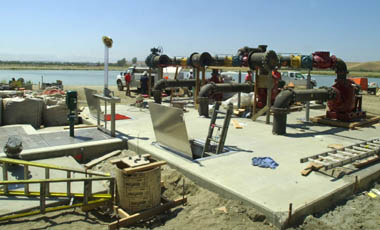Robert Scattini, the newest Hollister City Council member, isn’t
trying to be an expert on wastewater. He just wants to
”
get educated.
”
Robert Scattini, the newest Hollister City Council member, isn’t trying to be an expert on wastewater. He just wants to “get educated.”
Wastewater operations have been a priority of local leaders since the 15-million-gallon spill in May 2002, which was followed by a state-mandated building moratorium and a series of potential fines.
Scattini, who is partially responsible for a variety of crucial decisions about Hollister’s crusade to revamp its wastewater operations, requested a personal tour of the plants from Public Works Director Clint Quilter.
And I was given the privilege Wednesday of riding along on the afternoon excursion to the west side of town.
With Quilter driving the city-owned sports utility vehicle and Scattini on the passenger side, we pulled up to the first of 14 ponds – this one at the industrial plant. And Quilter explained its basic workings.
He said most treatment processes are managed biologically, Hollister’s included. An array of aerators – which look like fountains speckled across the water surface – create an environment conducive to insects by producing a surplus of air, he said.
The bugs function to eat the solid waste and are, in a sense, perpetually invited to an all-you-can-eat-dinner. Though Quilter phrased it more tactfully.
“The more air you’ve got, the more bugs you’ve got,” Quilter said. “The more bugs you’ve got, the better things work.”
We drove along the dirt path that meanders through the grounds, often with ponds on both sides of the road.
“This is where the levee break was,” Quilter said as we rounded the elevated corner of a pond.
“Right here, I’ll be (darned),” said Scattini, who pointed toward the San Benito River and said, “It flowed over there, huh?”
We left the industrial plant and drove on Highway 156 across the bridge over the riverbed to the nearby domestic plant.
Our first stop there was the newly built headworks system, which is about the size of an average-size house and looks like a roller coaster of large pipes. It sits off the shore of a pond.
“Now when you call it headworks (at Council meetings), I’ll know what the heck you’re talking about,” Scattini said.
The headworks is designed to improve the process of pumping wastewater among ponds. Furthermore, the new system is enclosed and, contrary to the old headworks, will not emit as much of a stench, he said.
In September, the Regional Water Quality Control Board mandated its construction to be finished by Aug. 1, or the city would be fined $200,000. Quilter said the transformation from the old system to the new system would begin today and likely finish Sunday.
“That’s $200,000 just checked off,” Quilter said.
The pond next to the headworks, Quilter said, will soon be the new location of treatment. I had trouble concentrating on Quilter’s lesson because two men performing maintenance stood on separate aerators, seemingly stranded, in the middle of the pond.
“I sure hope they don’t have to swim back,” I said.
Scattini laughed, and Quilter said a boat will eventually get them.
In the same pond, Quilter pointed out several rows of “baffles,” which, from a distance, resemble a series of rolled-up black tarps floating across the water surface. He compared them to curtains because each drops to the pond’s bottom.
They force wastewater to flow along a precise course, “zig-zagging” as Quilter called it, which he said causes an efficient method of settling the solids. And that raises efficiency of percolation, he said.
Of course I needed some clarification at that point. Percolation is when treated water filters into the ground. The reclamation method is treating the wastewater to the point where it can be reused.
Quilter told Scattini the city wants to eventually reclaim all wastewater for uses that include agriculture and golf courses.
“The problem now is the drinking water we have – the water that ends up down here, isn’t of a high enough quality to reclaim,” Quilter said.
The time line to improve the water ultimately relates to constraints of percolating into the ground, he said.
“How much can we perc?” he said. “How long can we continue to perc?”
As we drove along, we passed about a dozen goats that permanently reside at the plant to graze its vegetation.
“Is that the whole crew?” Scattini said, to which Quilter responded yes.
Our final stop was two emergency storage ponds, the subject of a lawsuit filed by the county against the city in December. The county filed suit because it claimed Hollister, in its construction of the ponds, did not follow a proper environmental review process.
The ponds were built to hold an additional 30-million gallons of wastewater as a protection from flooding during this year’s El Nino rainy season.
Quilter said the city filled one pond with only about four-million gallons of wastewater. Without the ponds, disaster would have been avoided because, he said, “we didn’t end up having that wet of a winter.”
We drove back toward the plant’s exit, and conversation turned more casual. We talked about weather and the families of ducks living in the wastewater.
“I would guess they can’t tell the difference between it and the slew,” Quilter said.










